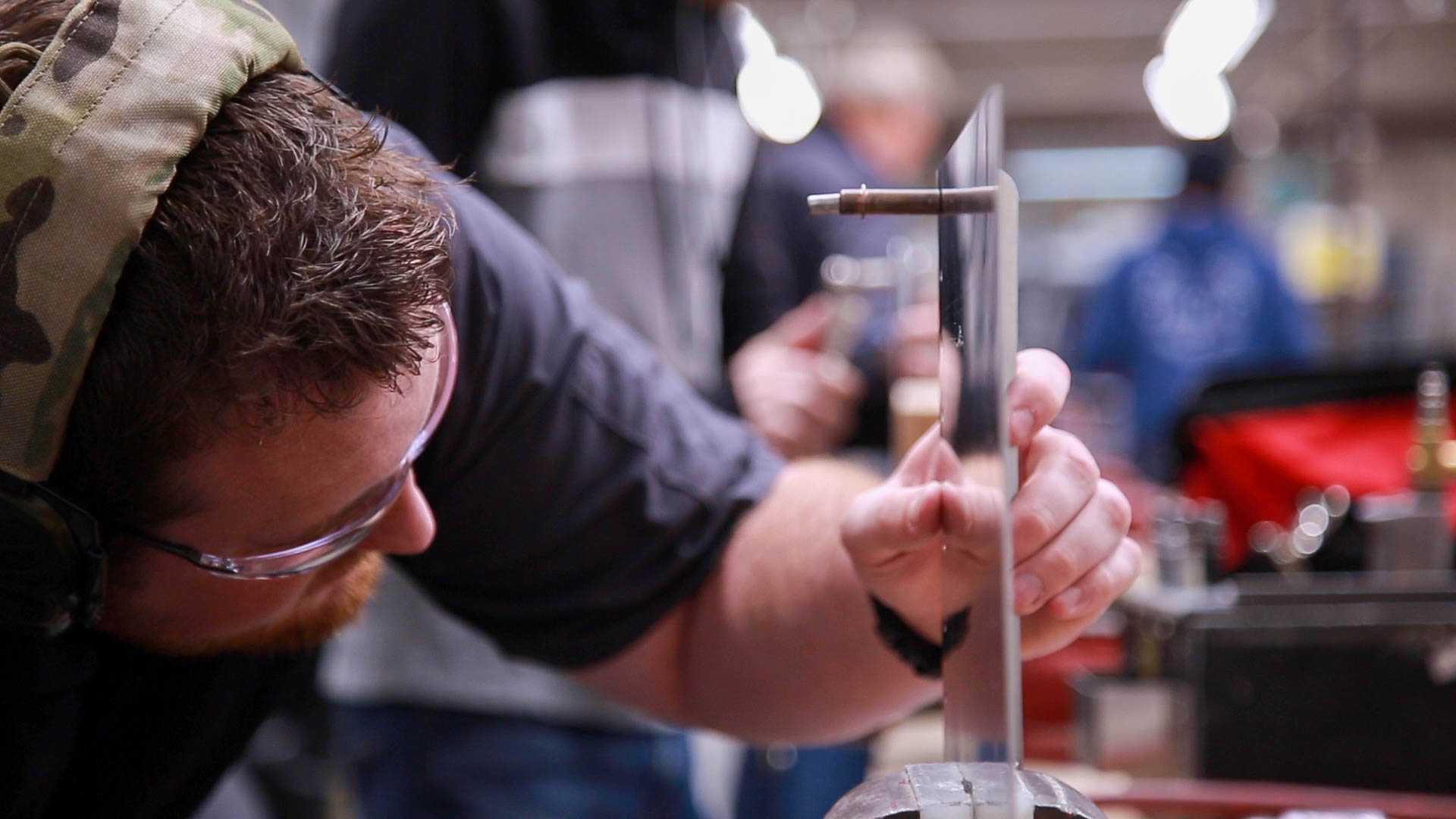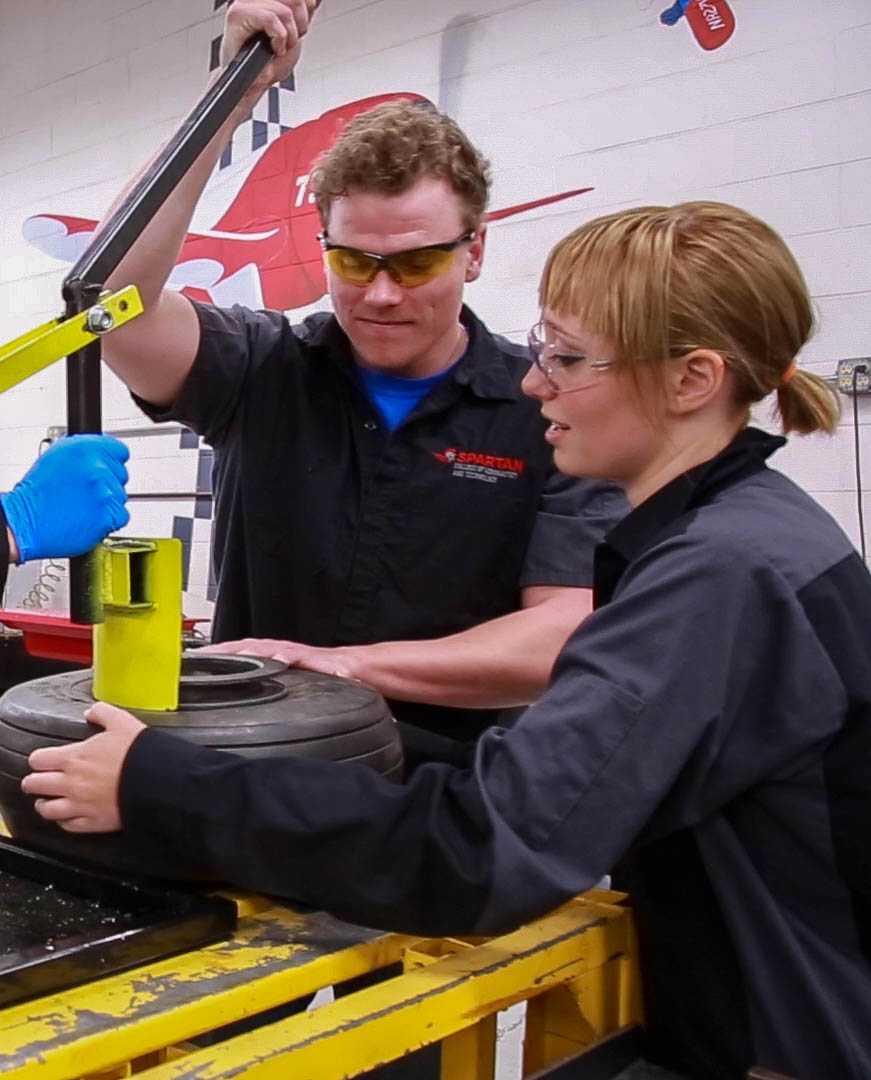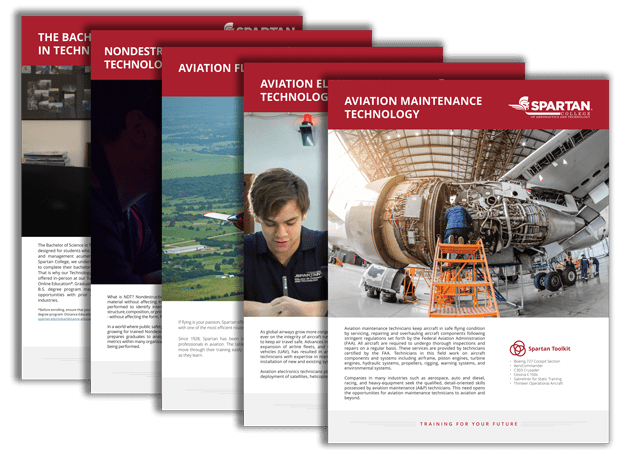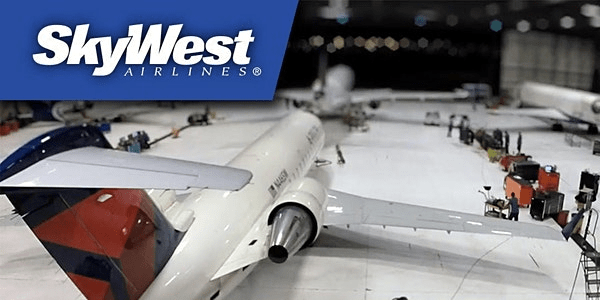Aviation Maintenance Technology In Denver Area

Training the Next Generation of Aviation Maintenance Technicians
Interested in Learning More?

Program Details
Associate of Applied Science Aviation Maintenance Technology
(Degree) · Program Length: 20 months
The program is designed to teach students the technical skills required to service, repair, and overhaul aircraft (or related) components and systems. Successful completion qualifies graduates to take the written, oral, and practical tests with the FAA for the Mechanic’s Certificate with both Airframe and Powerplant Ratings. The program is FAA Part 147 approved.
A Day in the Life of a Student:
- Repairing & assembling aircraft turbines
- Sheet metal fabrication & repair
- Learning about aviation science and theories
- Basic welding, paints & finishes
- Understanding various aircraft systems
- Electrical and fire protection systems

PREPARE FOR TAKEOFF BY GETTING A LAY OF THE LAND
Course Work
Part of the Demand for Airline Technicians
according to the Boeing Pilot Technician Outlook 2021 – 2040.
*Boeing: Pilot and Technician Outlook, http://www.boeing.com/commercial/market/pilot-technician-outlook/
WHAT EQUIPMENT DOES OUR SCHOOL HAVE TO OFFER?
NEARLY 40,000 SQ. FT. OF CLASSROOM AND LAB SPACE
NEARLY 40,000 SQ. FT. OF CLASSROOM AND LAB SPACE
OVER 80 POWERPLANTS INCLUDING TWO ROLLS ROYCE RB 211-22B TURBINE ENGINES
OVER 80 POWERPLANTS INCLUDING TWO ROLLS ROYCE RB 211-22B TURBINE ENGINES
GE WALTER 601D TURBOPROP 658 SHP
GE WALTER 601D TURBOPROP 658 SHP
THREE CESSNA 172S, A CESSNA 152, AND A BEECHCRAFT C-35 BONANZA
THREE CESSNA 172S, A CESSNA 152, AND A BEECHCRAFT C-35 BONANZA
FALCON 20
FALCON 20
Sample Classes
This course covers the theory and operation of reciprocating engines. All internal components are studied, along with how each part functions. A reciprocating engine is disassembled, measured, reassembled, and timed. Upon completion of this course, students are expected to be able to explain the operation of a reciprocating engine.
In this course, aircraft sheet metal structures and different fastening methods are studied in detail. Students will accomplish a wide variety of lab projects leading to an understanding of subject material. Upon successful completion of this course, students are expected to be able to perform all basic tasks required of an aircraft maintenance technician related to metallic structures.
The theory, operation, and maintenance of aircraft hydraulic and pneumatic systems are covered. The troubleshooting, maintenance, and repair of both systems is stressed. Aircraft landing gears, including retraction systems, oleos, brakes, wheels, and tires, are also studied. This course also includes study of aircraft position and warning systems.
Industry Outlook
- An A&P Technician inspects, services and repairs airplanes to ensure they're operating correctly and safely.
- A mechanic is responsible for ensuring that airplanes get regular maintenance and that any problems are fixed correctly.
- Technicians may work on different parts of an aircraft, such as the engine, landing gear, brakes and pumps.
- A Technician may work with special instruments designed specifically for aircraft maintenance. The job may also involve standing on ladders and working at various heights.
- Mechanics service different types of aircraft, such as helicopters, jets and propeller-driven airplanes.
- Assemble and fit aircraft structural parts.
- Rivet and derivet aircraft structural parts.
- Repair structural components.
- Perform a subassembly.
- Remove and install aircraft system components.
- Test components for wear and tear.
- Perform repairs as needed.
- Read and interpret drawings, diagrams and manuals, and produce sketches.
- Manufacture, modify, and repair sheet metal parts.
- Create structures, skins, and panels to exacting tolerances.
- Use and interpret structural repair manuals.
- Perform composite component fabrication and repair.
- Repair and overhaul rotary wings.
- Repair and overhaul fixed-wing aircraft.
- Perform CNC precision sheet metal fabrication and structural modeling.
- Create metal-to-metal structural adhesive bonding preparation of product specifications and compliance programs.
- Install and test mechanical and hydraulic flight control systems.
- Perform component testing.
- Create surface and thermal treatment weights.
- Align, fit, assemble, connect, or install system components, using jigs, fixtures, measuring instruments, hand tools, or power tools.
- Adjust, repair, rework, or replace parts and assemblies.
- Layout and mark reference points.
- Airframe specialists, also called airframe or aircraft mechanics, work on all parts of an aircraft with the exception of its instruments, power plant and propulsion system.
- They use precision instruments, X-rays and magnetic equipment to look for cracks.
- In addition, they repair and replace worn or defective parts, sheet metal and composite materials, and they check for problems such as corrosion in an aircraft's fuselage, wings and tail. Most airframe specialists who work on civilian aircraft have combined certification in airframes and power plants and are qualified to work on all parts except instruments; they are called combination airframe and power plant mechanics, or A&P mechanics.
- Mechanics in this position test all mechanical and electrical systems on aircraft, making all required changes and repairs prior to flight test.
- Aircraft Technicians need a strong working knowledge of all aircraft systems and various types of test equipment.
- Assemble tail, wing, fuselage, or other structural section of aircraft, space vehicles, and missiles from parts, subassemblies, and components and install functional units, parts, or equipment, such as landing gear, control surfaces, doors, and floorboards.
- Electro-Mechanical Technicians operate, test, maintain, or calibrate unmanned, automated, servo-mechanical, or electromechanical equipment.
- May operate unmanned submarines, aircraft, or other equipment at worksites, such as oil rigs, deep ocean exploration, or hazardous waste removal.
- Prepares work to be accomplished by studying assembly instructions, blueprint specifications, and parts lists.
- Gathering parts, subassemblies, tools, and materials.
- Positions parts and subassemblies by using templates or reading measurements.
- Performs scheduled and unscheduled inspections, maintenance, and repair of airframe and powerplant systems and components per acceptable methods, techniques, and practices.
- Documents work performed in accordance with Regulatory and Repair Station/Quality Manual policies and procedures.
- Demonstrates proficiency with the methods, techniques, practices, tools, and equipment used during aircraft maintenance.
- Identifies, protects, and preserves piece parts and articles undergoing maintenance in accordance with RSM/QCM and company policies and procedures.
- Assures parts, products and materials that are installed meet regulatory requirements.
- Performs assigned work in a safe effective manner while practicing good housekeeping in accordance with company and regulatory requirements.
- Provides detailed turnovers when maintenance is left unfinished prior to shift changes.
- Fabricate, assemble, install, and repair sheet metal products and equipment, such as ducts, control boxes, drainpipes, and furnace casings.
- Includes sheet metal duct installers who install prefabricated sheet metal ducts used for heating, air conditioning, or other purposes.
- Solid knowledge of electrical systems, air systems, chassis & suspension, HVAC, diesel engines & transmissions.
- Solid knowledge of operating theory, failure diagnosis, repair, & preventive maintenance practices common to buses & heavy vehicles.
- Solid skills working with common mechanic hand tools, pneumatic tools & diagnostic equipment.
- Solid knowledge of OSHA & safe working practices & procedures.
- Solid ability to read, to understand, and to use: maintenance, repair & parts manuals, computer-based maintenance information systems, Federal Motor Carrier Safety Regulations, service updates & troubleshooting guides.
- Basic knowledge of electrical & gas welding.
FAQ's
First, applicants must provide proof they’ve graduated high school or high school equivalency certificate based on the General Education Development (GED) test. Applicants will also need their high school transcript from an accredited institution. (However, an official copy of the military DD214 may be used as an official proof of high school graduation only if the document includes a specific graduation date.)
For a full list of prerequisites, check out our College Catalog for our Tulsa programs.
First, you need to provide proof you’ve graduated high school or high school equivalency certificate based on the General Education Development (GED) test. You will also need your high school transcript from an accredited institution – or an official copy of the military DD214 that includes proof of your graduation.
For a full list of prerequisites, check out the College Catalog for our Denver-area programs.
Great question, Spartans have gone to work in roles like:
- Aircraft Line Support
- Aviation Maintenance Technician with major airlines
- Composite Technician
- Engine Overhaul and Repair Technician
- Aircraft and Aerospace Manufacturing Assembly and Testing
- Transit System Technician
- Airframe Technician
- General Aviation Technician (Business Jets)
- Traveling Contracted Aviation Technician
To make sure you have the most up-to-date information about the cost of our Aviation Maintenance Technology program, we regularly update our Catalog Supplement guide. Get into contact with Admissions representatives for more clarity about the program, cost, and financial aid opportunities for those who qualify.
This is the perfect time to direct you to the College Catalog. If you want the spark notes, you will be attending classes like Reciprocating Engines, Metallic Structures, and Hydraulics and Landing Gear Systems among others.
You’ll explore aviation maintenance and the technologies associated with the rapidly evolving aviation and aerospace industry, including everything from fuel metering and propellers to aircraft instrumentation. You will also get familiar with small single engine planes to large passenger and cargo transport planes used at major airlines.
Yes, you wouldn’t have cookies without milk, would you?
Students earning their associate’s degree study in seven general education courses. Due to program changes, the exact number of courses may change.
Our campuses have set schedules. Most folks find it fits into their busy lifestyle.
Day Shift
- Aviation Maintenance Technology (AMT) – AAS from 7:30 am - 2:30 pm
- Aviation Electronics Technology (AET) - AAS from 7:30 am - 2:30 pm
Night Shift (Monday through Friday)
- Aviation Maintenance Technology (AMT) – AAS from 4:00 pm - 11:00 pm
Some things can’t and shouldn’t be simplified. Check out the College Catalog for our Denver-area program for a full break down of requirements.
The certification process is included in your cost of tuition for your first test attempt, if you take them within 45 days of graduation. It requires three written exams and an oral and practical exam with an FAA designated examiner.
No.
You can find real alumni testimonials on the Spartan Alumni page on our site. Included you’ll find links to several services alongside our Denver-area testimonials.
You probably have a lot of questions about college. If you don’t find the answers you need on these pages, just call 303-410-2403 to speak with an admissions representative.
